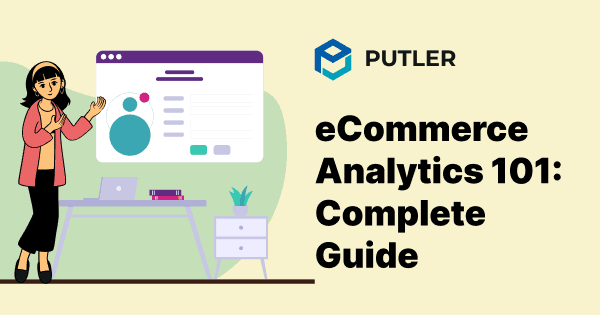The digital revolution is here, and you’ve invested big in your online business. But one wrong move could spell disaster.
With fierce competition, you can’t afford to rely on guesswork. That’s where eCommerce analytics comes in. Not familiar with the term? Don’t sweat it.
In this guide, we’ll explore eCommerce reporting and why it’s crucial for your success.
Let’s dive in and discover how analytics can help you make smart decisions that’ll put you ahead of the pack.
What is eCommerce analytics?
eCommerce analytics is the superpower your online business needs to thrive. It’s a data-driven approach that transforms the numbers and clicks on your website into actionable insights. Here’s how it works:
eCommerce analytics collect data from every corner of your online store – from customer behavior to product performance to marketing campaigns.
They then organize this information into easy-to-understand reports and dashboards. With these insights at your fingertips, you can make smarter, data-backed decisions. Optimize your product pages to boost conversions.
Identify your most profitable customer segments. Pinpoint where you’re losing sales and plug those leaks. The possibilities are endless when you have a clear, data-driven view of your business.
The best part? You don’t need a PhD in statistics to make the most of eCommerce analytics. If you’re new to eCommerce analytics, try a free demo from Putler to see how it can help your business.
Importance of eCommerce analytics
Think of eCommerce analytics as a companion in your business’ growth journey. This tool will answer all your queries pertaining to your website activity. This being said, let’s dive into why you really need to bother with it.
You will know what’s working for you. You probably know for a fact that you have a limited number of resources at your disposal. Marketing requires a budget to function. Having eCommerce reports will give you detailed insights on areas that are reaping benefits as well as those that are lagging you behind.
Having a direction will allow you to allocate your budget to the right places to thrive.
What are the major benefits of eCommerce reporting?
Here are the significant benefits of eCommerce reporting.
- Data is powerful: Using eCommerce data helps you understand customer behavior and trends. This knowledge allows you to make smart decisions, create targeted strategies, and grow your business by truly understanding what your customers want.
- Bring higher conversions: Customer data lets you continuously improve your website and marketing efforts. By testing and refining content, design, and marketing channels, you can offer personalized experiences that turn more visitors into loyal customers.
- Build targeted funnels: By segmenting your audience based on their behavior, you can create automated marketing funnels that are highly effective. These funnels help you nurture leads, re-engage past customers, and encourage repeat business with tailored messages and offers.
- Predict future trends: Predictive analytics use past data to forecast future sales and customer behavior. This helps you anticipate changes in the market, stay ahead of competitors, and make informed, proactive decisions.
- Enhance security: By closely monitoring your data, you can quickly spot suspicious activities and prevent fraud. This helps protect your business and customers while ensuring compliance with regulations.
- Streamline multi-channel operations: Integrating data from all your sales channels into a single platform gives you a clear, real-time view of your business. This makes it easier to collaborate, solve problems, and optimize performance across your entire company.
What are the best Metrics and KPIs to track for eCommerce?
Tracking the right metrics and KPIs is crucial for any eCommerce business looking to grow and succeed. To help you out, here are some of the best metrics and KPIs to track:
- First up, performance metrics: These will give you insights into your website’s overall performance, such as traffic, bounce rate, and load time.
- Next, marketing metrics: These will help you understand the effectiveness of your marketing campaigns, including metrics such as click-through rates, conversion rates, and cost per acquisition.
- Don’t forget customer metrics: These will give you insights into your customers’ behavior and preferences, such as customer lifetime value, repeat purchase rate, and average order value.
- Product metrics: Metrics such as inventory turnover rate, product margin, and product page views are also important to track.
- When it comes to conversion optimization: Metrics such as cart abandonment rate, checkout completion rate, and product return rate can help you identify areas for improvement.
- Lastly, user experience metrics: These are critical to ensure a smooth and enjoyable shopping experience for your customers. These can include metrics such as page load time, mobile responsiveness, and user feedback.
These metrics and KPIs will give you the insights you need to make data-driven decisions and optimize your eCommerce business for success.
Learn key eCommerce analytics metrics for success
Every metric has a story to tell. Every click, every view, every impression, and every conversion leads to something. What you really need to do here is understand the numbers that your website is trying to tell you. You can do so by keeping an eye on key metrics like:
Category metrics table
| Category | Metrics | Description |
|---|---|---|
| Sales and Revenue Metrics | Net Sales | Total revenue after deductions. |
| Gross Margin | Profit after subtracting the cost of goods sold. | |
| Average Order Value (AOV) | Typical amount spent per order. | |
| Conversion Rate | Percentage of visitors who make a purchase. | |
| Refund Rate | Percentage of sales returned by customers. | |
| Customer Metrics | Customer Lifetime Value (CLV) | The total spend of a customer over time. |
| Customer Acquisition Cost (CAC) | Expense to gain a new customer. | |
| Churn Rate | Percentage of customers lost over a period. | |
| Repeat Purchase Rate | How often do customers buy again. | |
| RFM Analysis | Customer segmentation based on Recency, Frequency, and Monetary value. | |
| Product Performance Metrics | Best Sellers | Top-performing products. |
| Worst Performers | Products that aren’t selling well. | |
| Quantity Sold | Quantity sold per day. | |
| Average Revenue from Product Sales | The amount of revenue generated from the sale of individual products. | |
| Frequently Bought Together | Products often purchased in combination. | |
| Traffic and Audience Metrics | Unique Visitors | Individual users visiting your store. |
| Views | The total number of times a page or content is viewed by users. | |
| Bounce Rate | Percentage of single-page visits. | |
| Popular Search Terms | The most frequently used search queries by users on your site. | |
| Popular Pages | The pages on your site that receive the highest number of views or traffic. | |
| Click-Through Rate (CTR) | The percentage of users who click on a link or ad after seeing it. | |
| Subscription Metrics | Monthly Recurring Revenue (MRR) | Predictable monthly income from subscriptions. |
| Churn Rate | Percentage of subscribers lost. | |
| Average Revenue Per User (ARPU) | Typical revenue from each subscriber. | |
| Lifetime Value (LTV) | Expected total revenue from a subscriber. | |
| Renewal Rate | Percentage of subscribers who renew their subscription. | |
| Financial Metrics | Return on Investment (ROI) | Profitability of your investments. |
| Average Revenue/Sale | The average amount of revenue earned from each individual sale. | |
| Gross Sales | The total sales made during the selected date range. | |
| Fees | The total fees incurred for all transactions. | |
| Gross Profit Margin | Percentage of revenue retained after cost of goods sold. | |
| User Experience Metrics | Site Search Usage | Frequency of internal search use by visitors. |
| Cart Abandonment Rate | Percentage of users who add items but don’t purchase. | |
| Checkout Completion Rate | Percentage of users who finish the purchase process. | |
| Page Load Time | Speed of your website loading. | |
| Mobile Responsiveness | How well your site performs on mobile devices. |
Advanced analysis techniques in eCommerce
To take your eCommerce analytics to the next level, consider implementing these advanced techniques:
1. Cohort Analysis
Cohort analysis groups customers based on shared characteristics or experiences within a defined time. This technique helps you understand how different groups of customers behave over time.
Key benefits:
- Identify trends in customer retention and churn.
- Understand the long-term value of customer acquisition channels.
- Optimize your marketing strategies for specific customer groups.
Example: You might analyze how customers who made their first purchase during a holiday sale perform in terms of retention and repeat purchases compared to those who first bought during a non-promotional period.
2. Customer Segmentation
Customer segmentation divides your customer base into groups with similar characteristics, allowing for more targeted marketing and personalized experiences.
Key segmentation criteria:
- Demographic data (age, gender, location).
- Behavioral data (purchase history, browsing habits).
- Psychographic data (interests, values, lifestyle).
Benefits:
- Tailored marketing messages for higher conversion rates.
- Improved customer experience through personalization.
- More efficient allocation of marketing resources.
Example: You could create segments for “high-value customers,” “frequent browsers but rare buyers,” and “one-time purchasers” to develop specific strategies for each group.
3. Predictive Analytics
Predictive analytics uses historical data, statistical algorithms, and machine learning to identify the likelihood of future outcomes.
Applications in eCommerce:
- Forecast inventory needs to prevent stockouts.
- Predict customer churn and take proactive retention measures.
- Anticipate trends in customer behavior and preferences.
Benefits:
- Improved decision-making based on data-driven predictions.
- Proactive problem-solving before issues arise.
- Enhanced customer experience through anticipation of needs.
Example: Use predictive analytics to forecast which products are likely to be popular in the coming season, allowing you to stock up appropriately.
Google Analytics can help you
In the world of eCommerce, Google Analytics is considered the analytics tool for insights. With its user-friendly interface and comprehensive analytics feature, it has simply become one of the best integration tools for websites. Let’s not forget that it’s completely free!
It’s easy to connect GA with your website. You have to integrate and enable the system to set up tracking. First, you need to set up your Google Analytics account and enable it across your website and mobile application.
- Google has explained the entire process very comprehensively on their website. Here is the resource: Getting Started With Google Analytics
- Next, you need to set up your Analytics account for eCommerce tracking and reporting: Set Up eCommerce Tracking
Just follow the steps mentioned and you should be good!
Google is great, but it lacks something…
Although Google Analytics is great, it still leaves a lot to desire. It is comprehensive, yet not comprehensive ENOUGH for eCommerce platforms.
Need for customer analysis
We can’t specify the importance of customer profiling enough. An eCommerce business runs solely on what the customer needs and demands. Hence, having insights into your audience’s online behavior is crucial.
Google Analytics tracks only the location and time of a customer’s visit. It doesn’t give you detailed insights into the customer’s activities or profile. This will later become a hindrance for small owners and it might lead them to make wrong marketing decisions that would be directed based on only geography.
Need for product analysis
Products are your bread and butter. As an eCommerce business owner, knowing how your products are performing should be a routine task. You need to have insights into the products that are driving your business and the ones that are lagging you behind. If you launch something new, then you need to keep an eye on its performance for at least a few months until you decide to remove it. Google Analytics gives you only basic product reports. There is a lot that you’re missing out over here.
Other limitations
- GA tends to calculate either extra or fewer data, it creates issues and gives you an error when you count total sales or total products.
- It does not calculate refunds. Refunds are an important part of any eCommerce website and if those don’t get calculated then you may end up with haywire profits.
- For your subscription business, you need important metrics like LTV, MRR, churn rate etc. Google Analytics does not provide you with any of the above.
- GA does not allow integrations with third-party businesses like PayPal, Stripe, Braintree, Etsy, WooCommerce, etc. This becomes limiting for businesses that rely on these third-party tools.
Need for conversion tracking
Won’t you be amazed if someone showed you how you achieved conversions? Conversion analytics is basically tracking conversions and the details pertaining to it. What Google Analytics does is that it shows you the number of conversions that you have received on your marketing campaigns. What it fails to do is show you the revenue that you’ve generated on those conversions or which audiences were converted.
If this handy information is available, it can turn into a handicap for business owners.
But don’t worry there are tools crafted to help you. Let’s check them out.
eCommerce analytics tools that outperform Google Analytics
There are various third-party tools available in the market that can easily replace Google Analytics. These tools don’t just provide you with standard eCommerce data analytics but also give you insights on audience, conversions, products, and so on.
Mixpanel
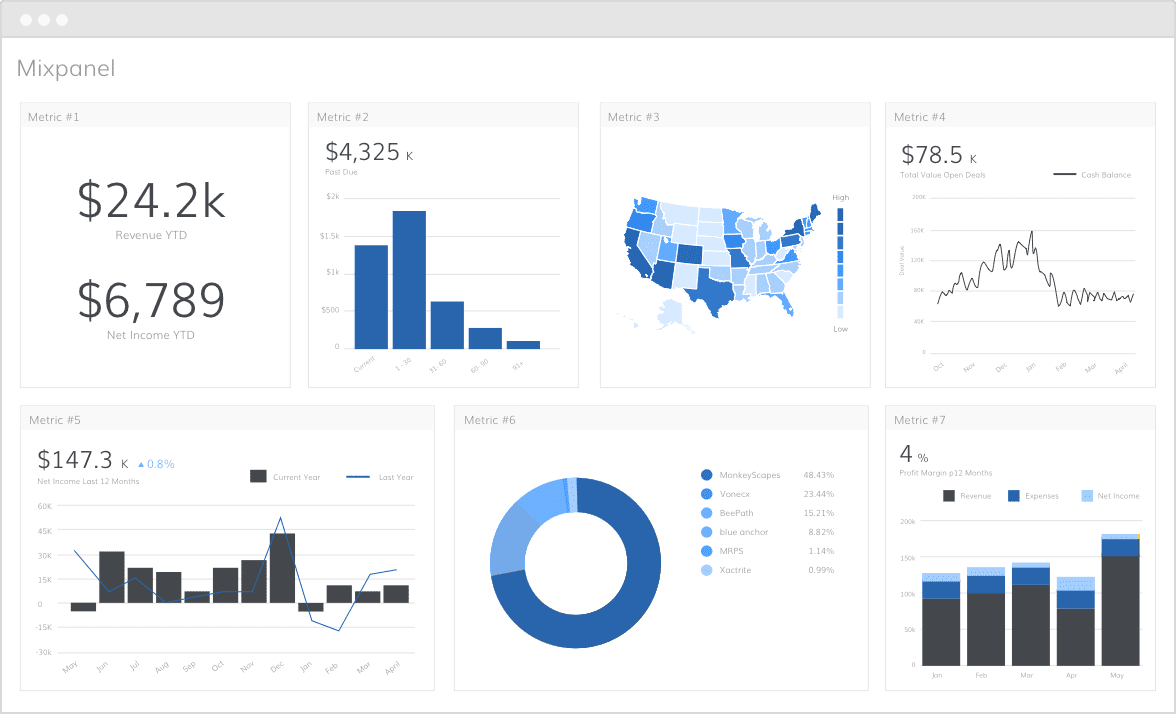
Mixpanel is primarily an analytics platform that has built-in tracking features for conversion rates and data. It measures customer actions which are defined as ‘events’ and accumulates data for your viewing.
Kissmetrics
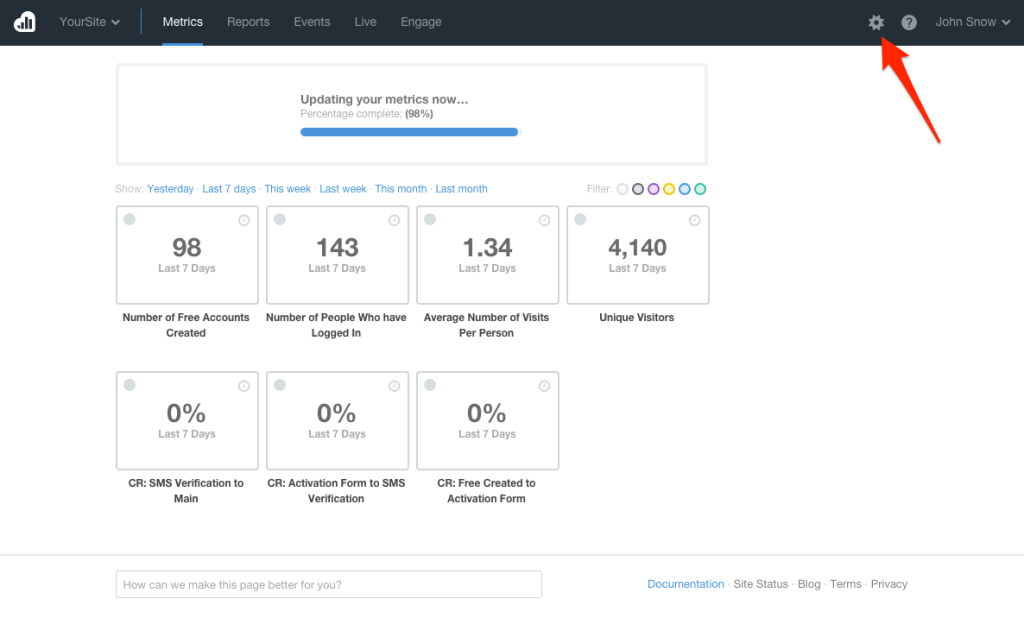
Kissmetrics is a paid analytics platform that has a user-friendly and easy-to-track customer conversion process. With this eCommerce reporting tool, you can find out where you’re acquiring customers and the areas that need adjustments.
Heap
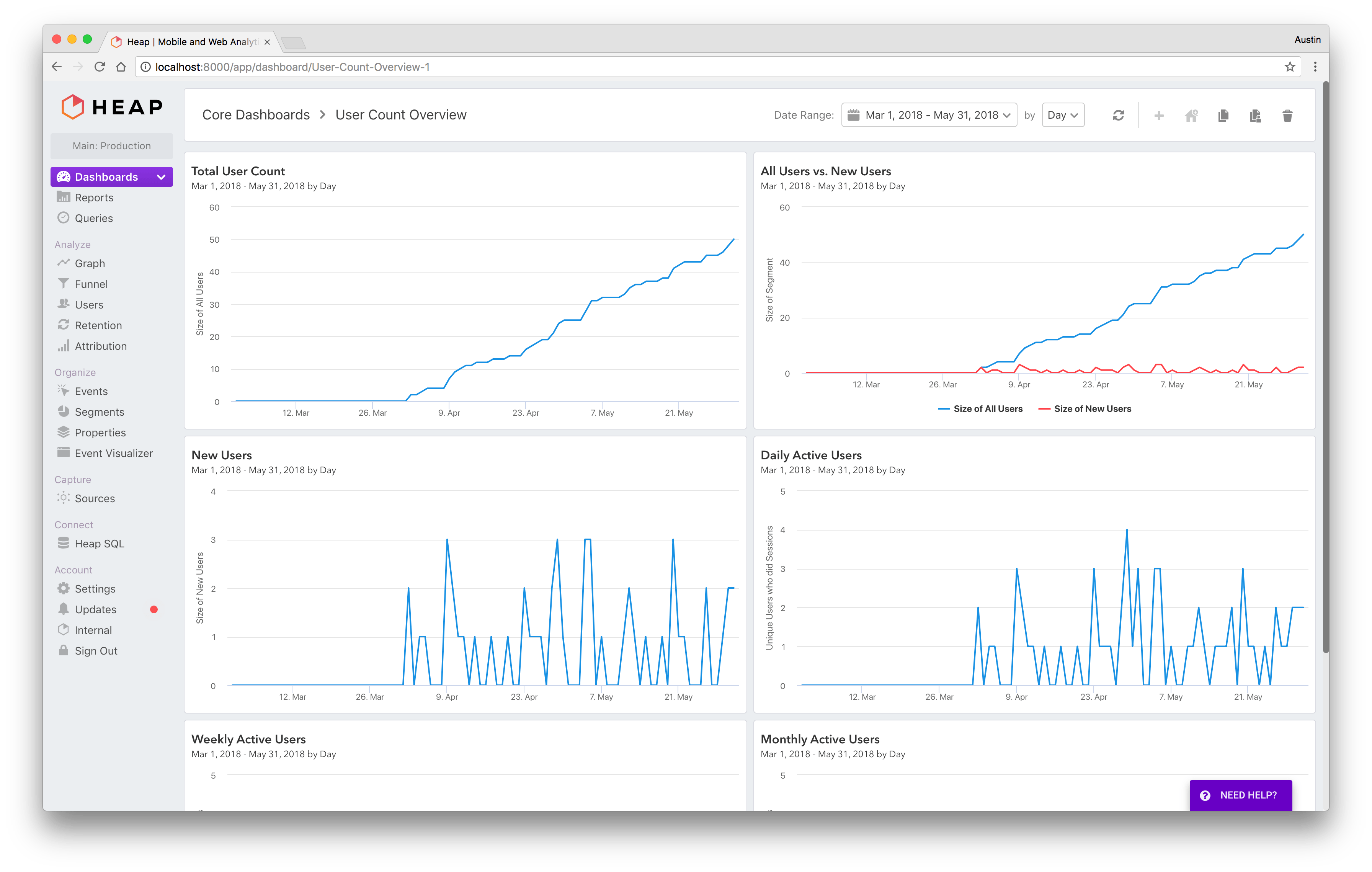
Heap is a great conversion tracking tool that accumulates customer actions from website and mobile applications and aggregates them. It provides you with retroactive analysis and displays every type of action that a user takes on your website.
These tools are pretty handy to manage your data.
But what if you get all this and more in a single platform?
Putler is an eCommerce reporting platform that cumulates data from every single area of your eCommerce website and converts it into actionable insights that help you make business decisions.
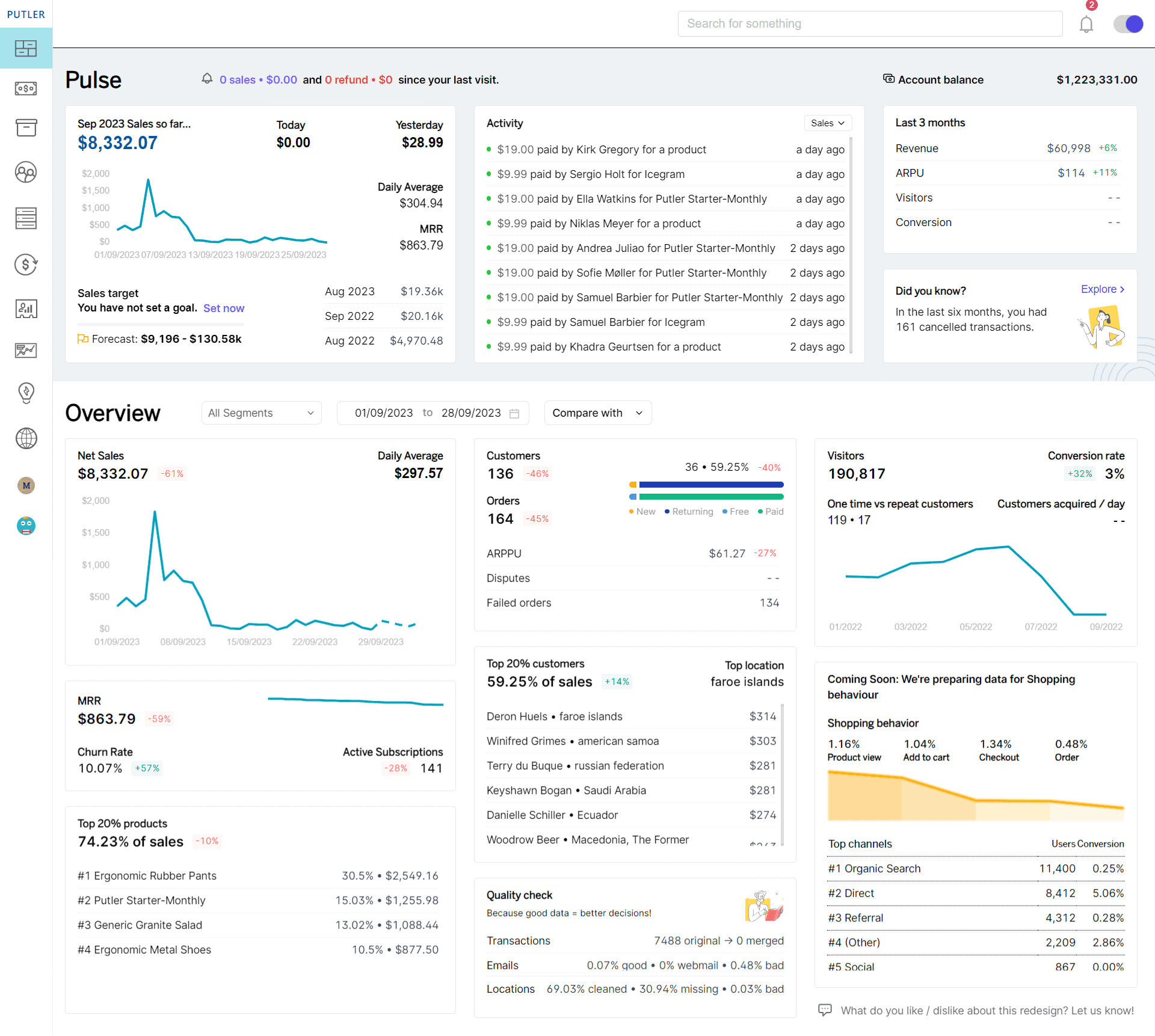
At Putler, we have worked with numerous clients who required help with data. We make a conscious decision to understand our clients businesses. Many a time, they find it tough to decipher the data that their website has collated even after using eCommerce analytics tools.
Hence, with all their pain points in mind, we make a conscious effort to equip Putler with all the features that an eCommerce business may need.
What are the eCommerce analytics and reports available in Putler?
Putler comes with tons of analytics and reports that can help you achieve your eCommerce business goals. Here are a few of them.
Customer reports
Know your customers in and out with the help of Putler’s customer tracking. Now you can find all types of customers like new,returning, lost, average LTV, top 20% customers, refunded customers, etc
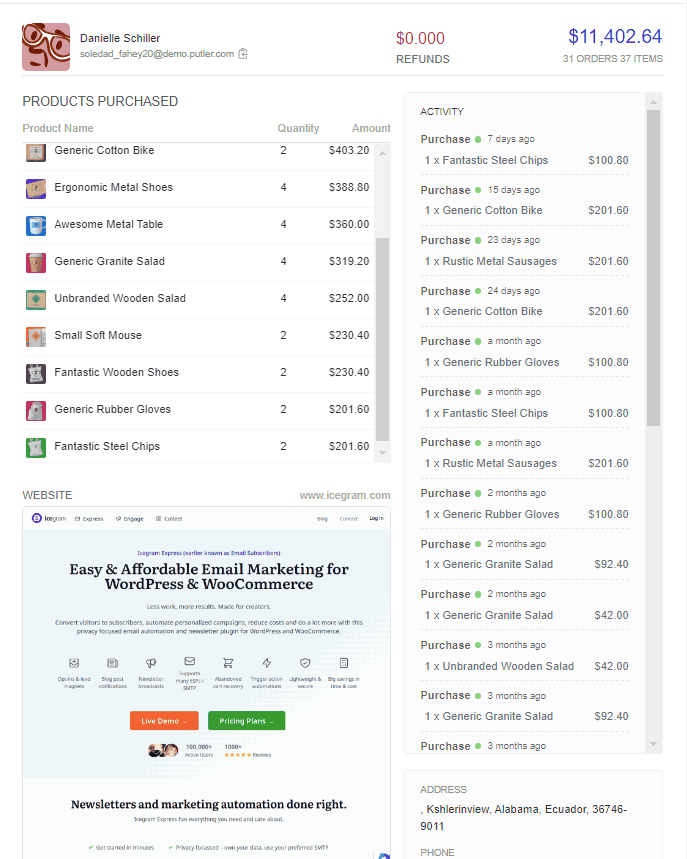
Customer segmentation
Putler doesn’t just segment customers for you, it does it based on customer activities like recency, frequency and monetary among other factors like location, time, date etc. With this, you’ll be able to decipher the most profitable customers, customer profile, curbed customers etc and create funnels that suit your campaigns.
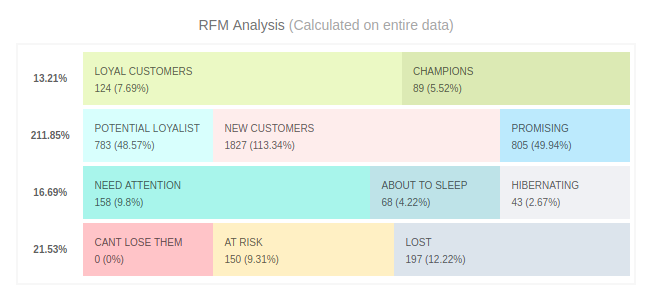
Sales report
Get a detailed sales report based on date, day, month, year, audience etc. Putler creates your own sales heatmap for you to decipher. You can look at sales trends, net sales, refunds, average sales, etc.
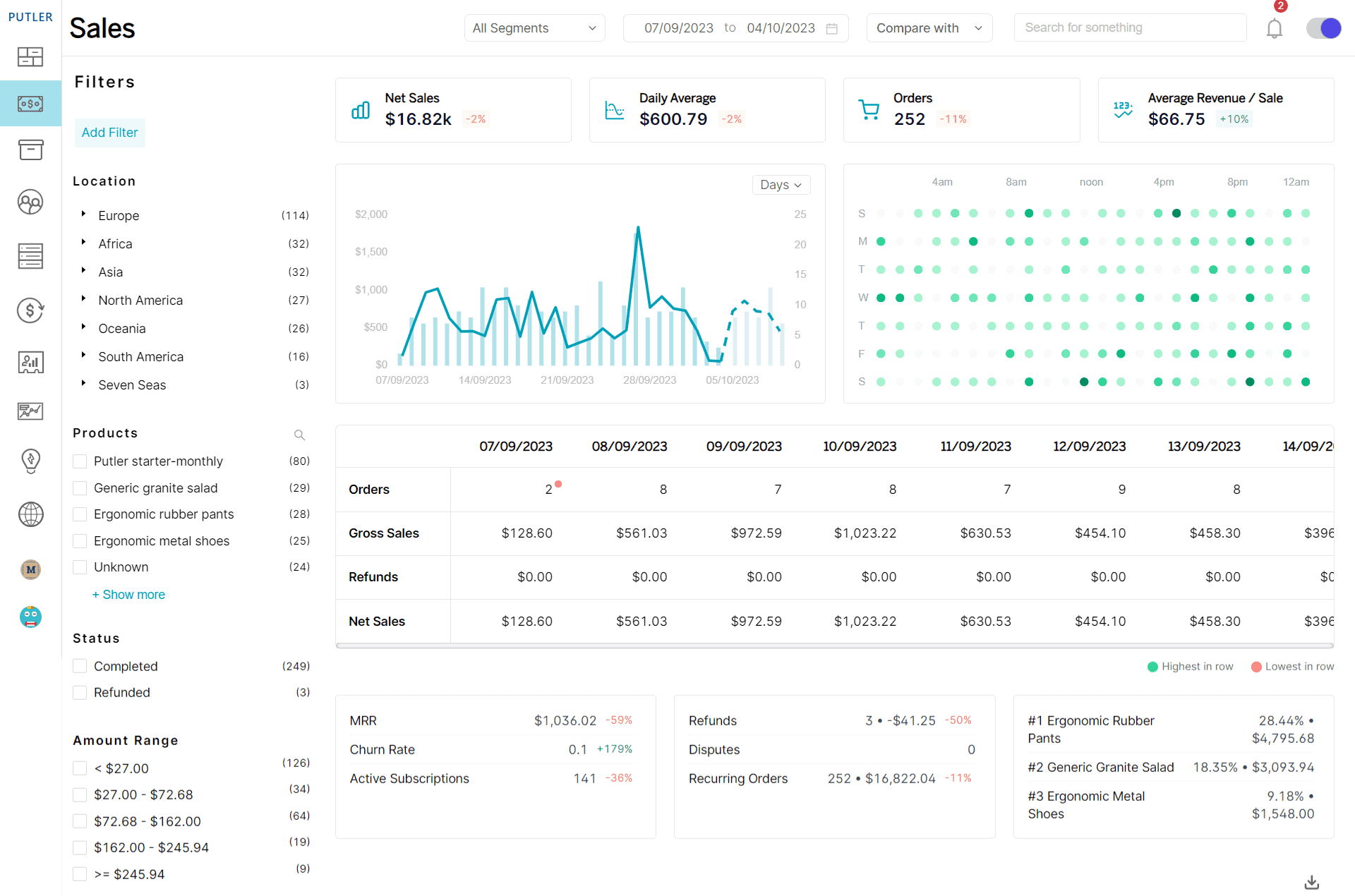
Product report
Know which products are performing well. Filter data as per your need and understand what your customers like and don’t like. Putler’s product report will give you minute actions that are taken for every product. This way, you can keep a track of everything.
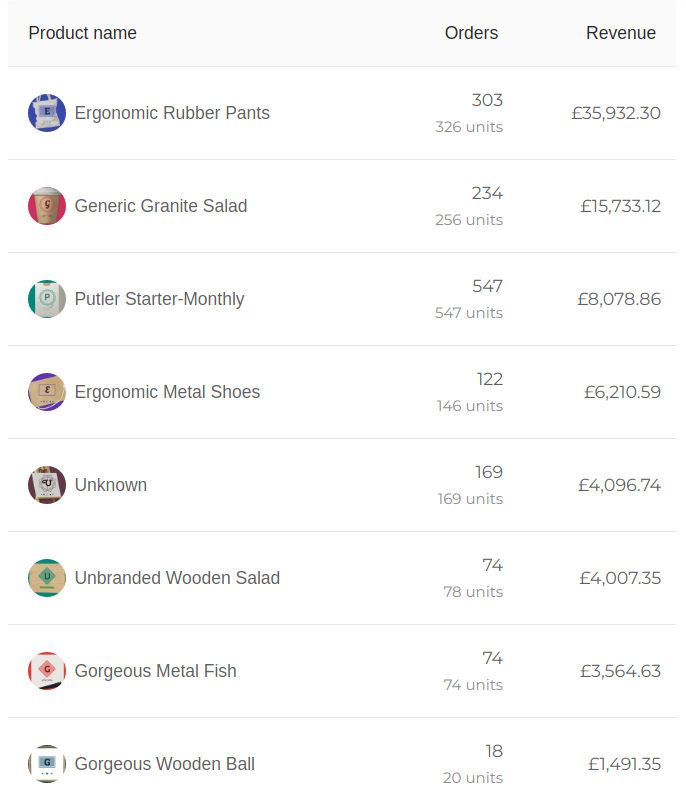
Audience report
Audience report will not just give you insights into the profile of your audience but also their actions. Putler assimilates every action done by an audience whether it’s visits, clicks, conversion process, impressions, click-through rates, position, profitability, popular pages, etc. You can also find the amount of revenue that audiences generate for your business.
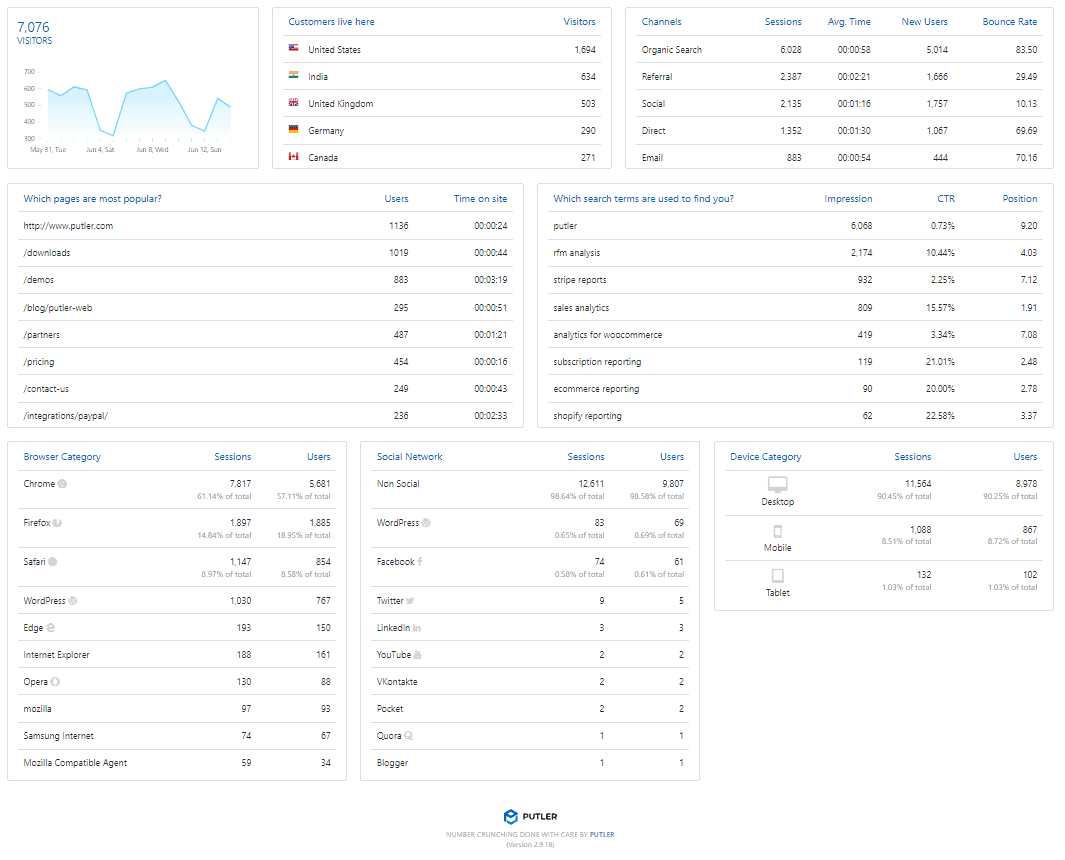
Subscription report
Subscription report dives deep into SaaS metrics that we mentioned above like LTV, MRR, ARPPU, user churn rate, revenue churn rate, growth rate, revenue refund, total subscriptions, subscription statuses, etc.
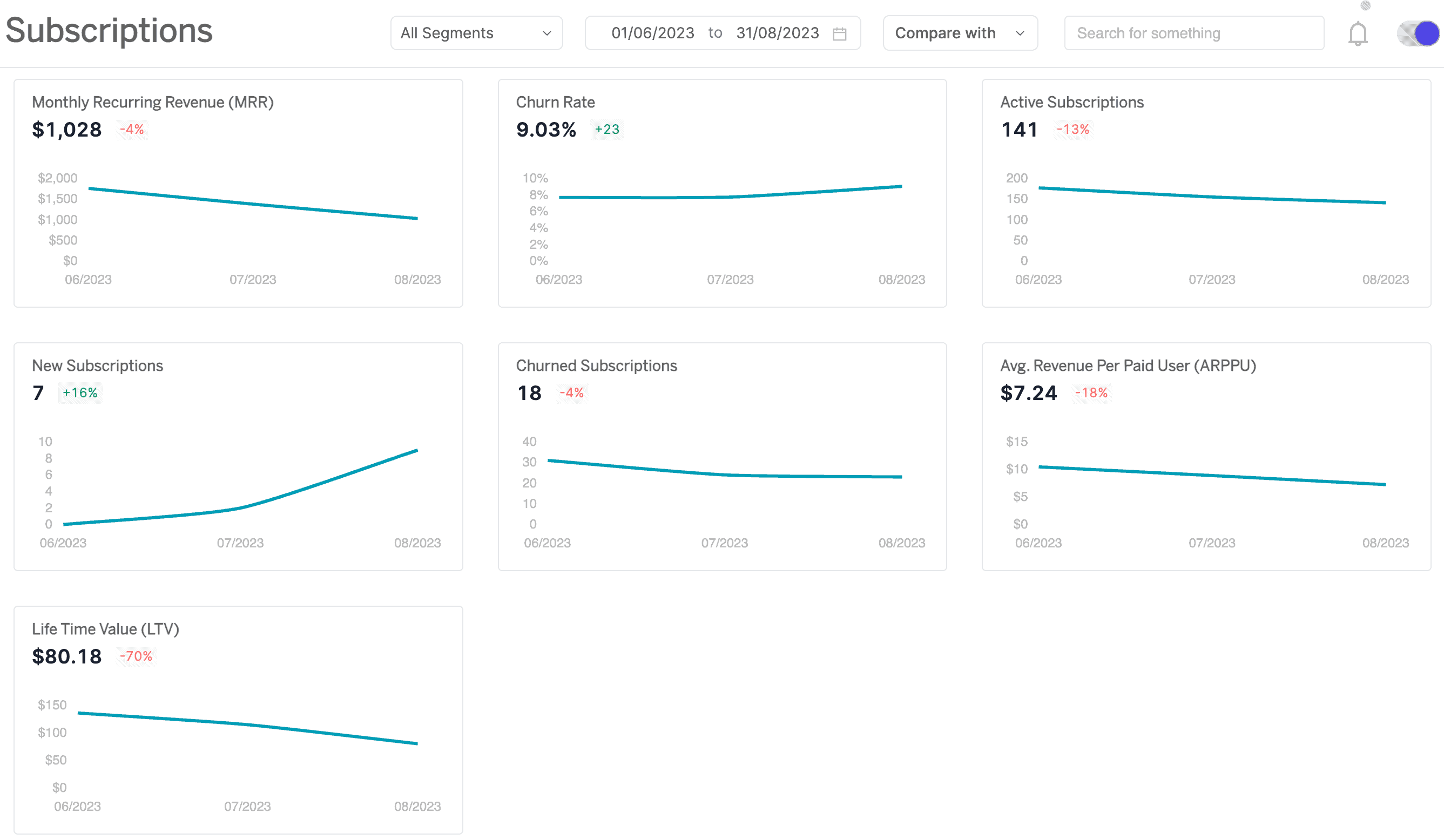
Transactions
Putler dives deep into transactions that happen on the website like fees, taxes, refunds, revenue, etc.
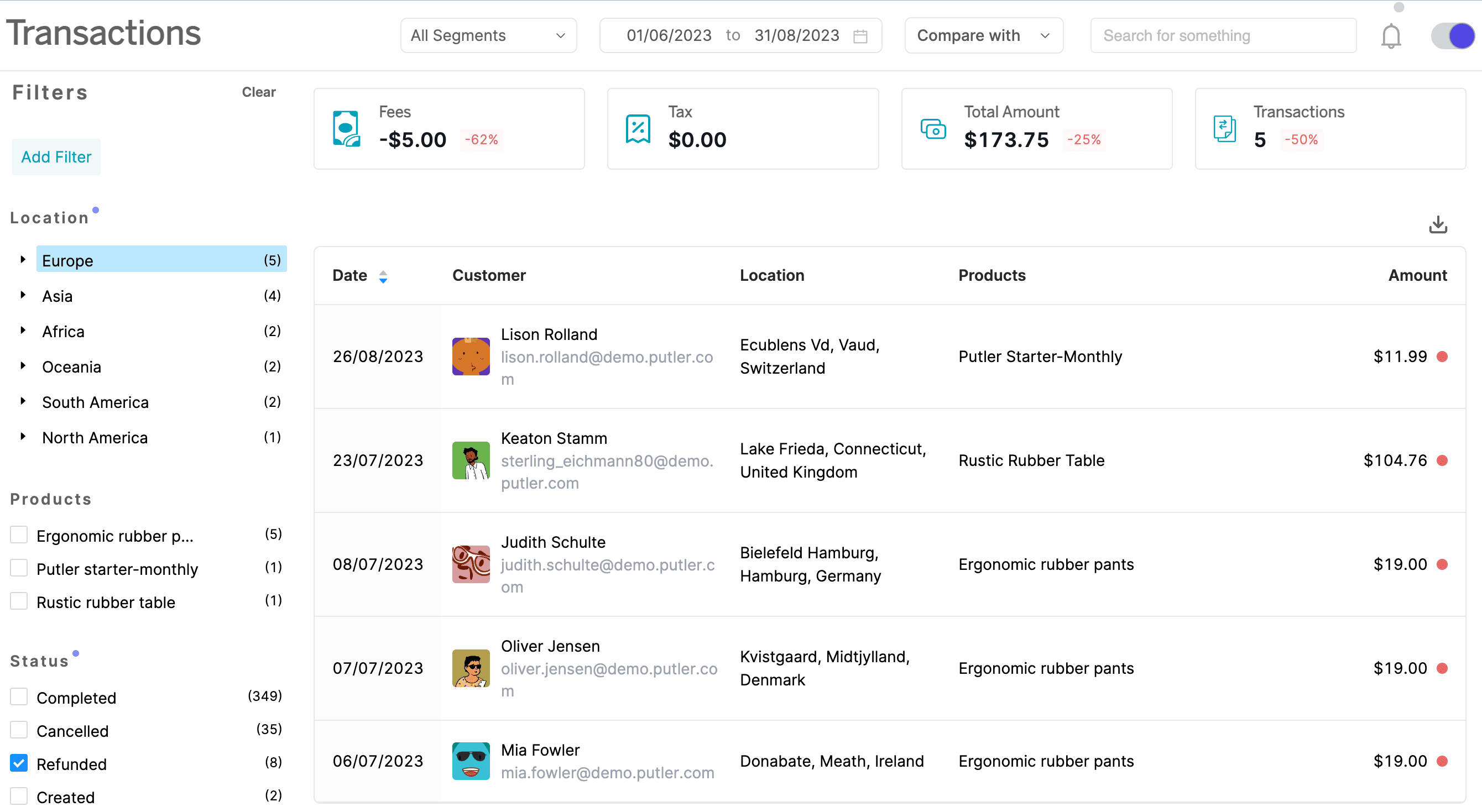
Time machine
We don’t just measure, we help you forecast your performance based on current metrics. We forecast revenue and sales, customer acquisition, conversion targets, churn, etc. You literally have your very own time machine.
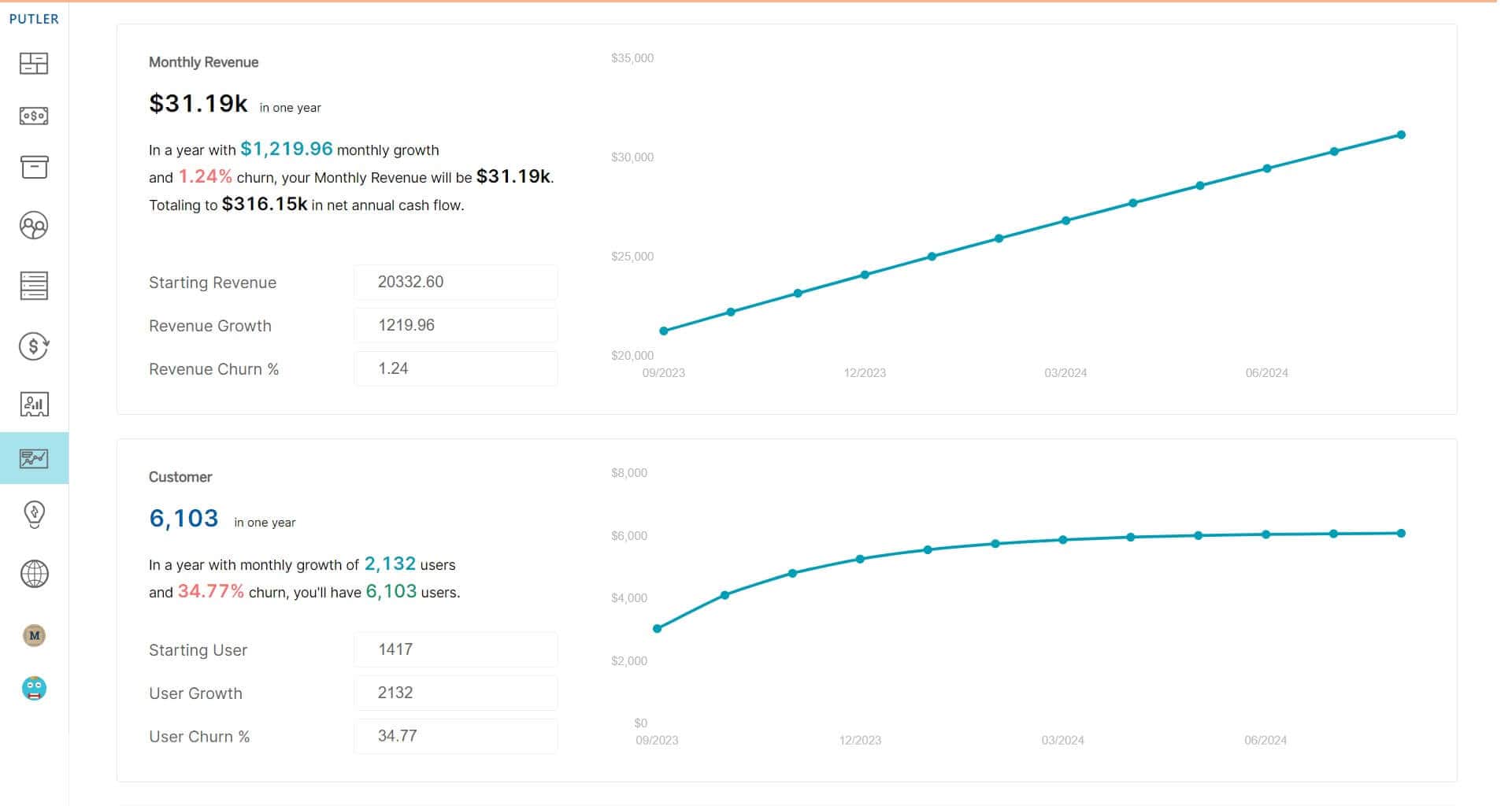
Insights
How would you feel if you asked for a slice of pizza but got the whole thing? Putler does more than report; we give you relevant insights based on holiday season sales, daily average, ARPU, visitors, best holidays, etc.
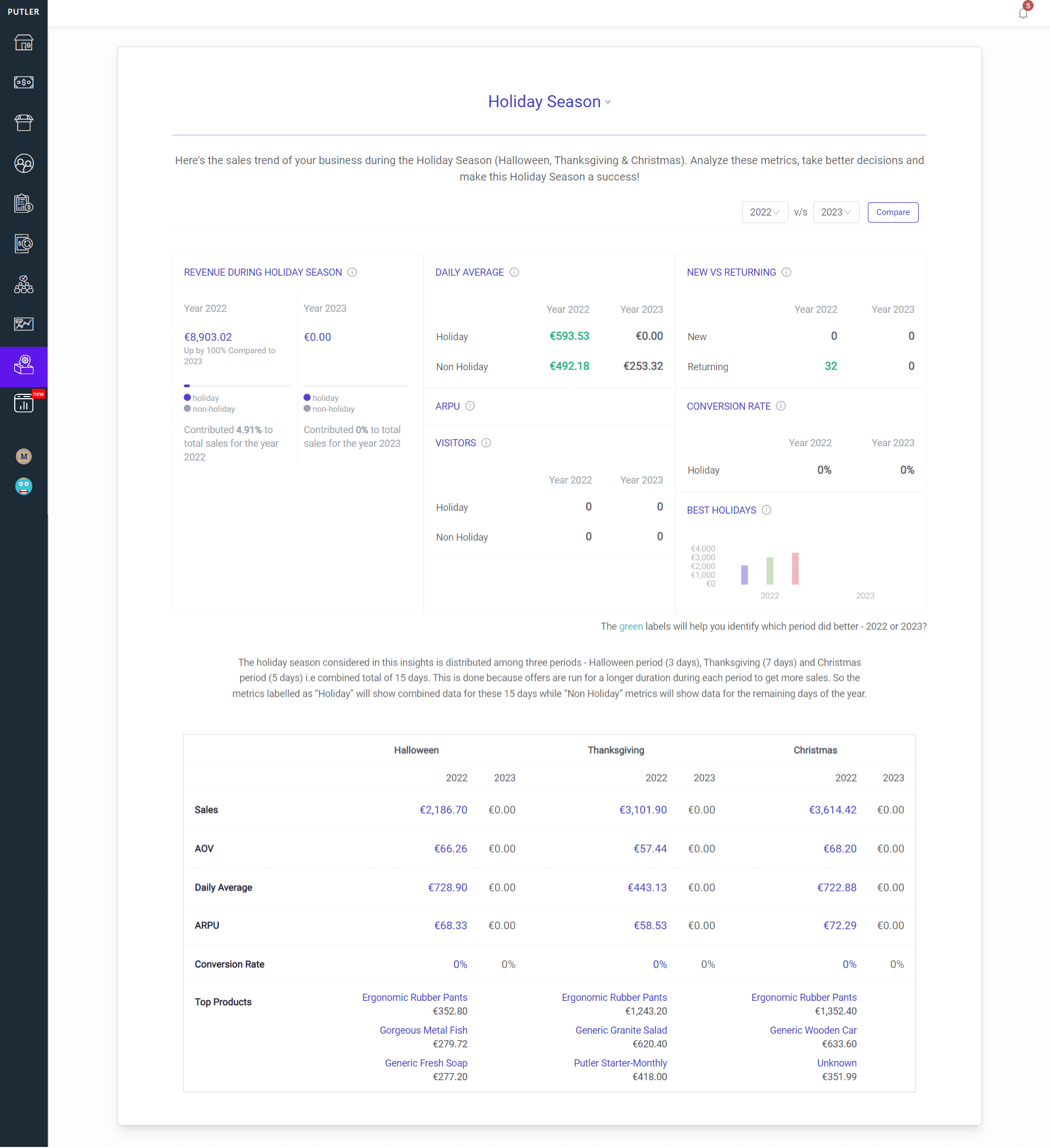
Multi-store reporting
Have more than a single store to manage? No stress! Putler can aggregate data from all your stores and converts it into comprehensive actionable insights by using a single dashboard. So you will have multiple stores but a single tool to handle each.
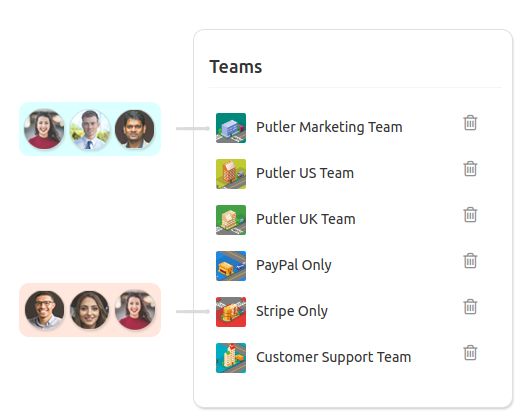
Multi-channel integration
Putler can integrate with multiple businesses like PayPal, Stripe, Braintree, Etsy, WooCommerce, Gumroad, Mailchimp, Shopify, EDD, etc.
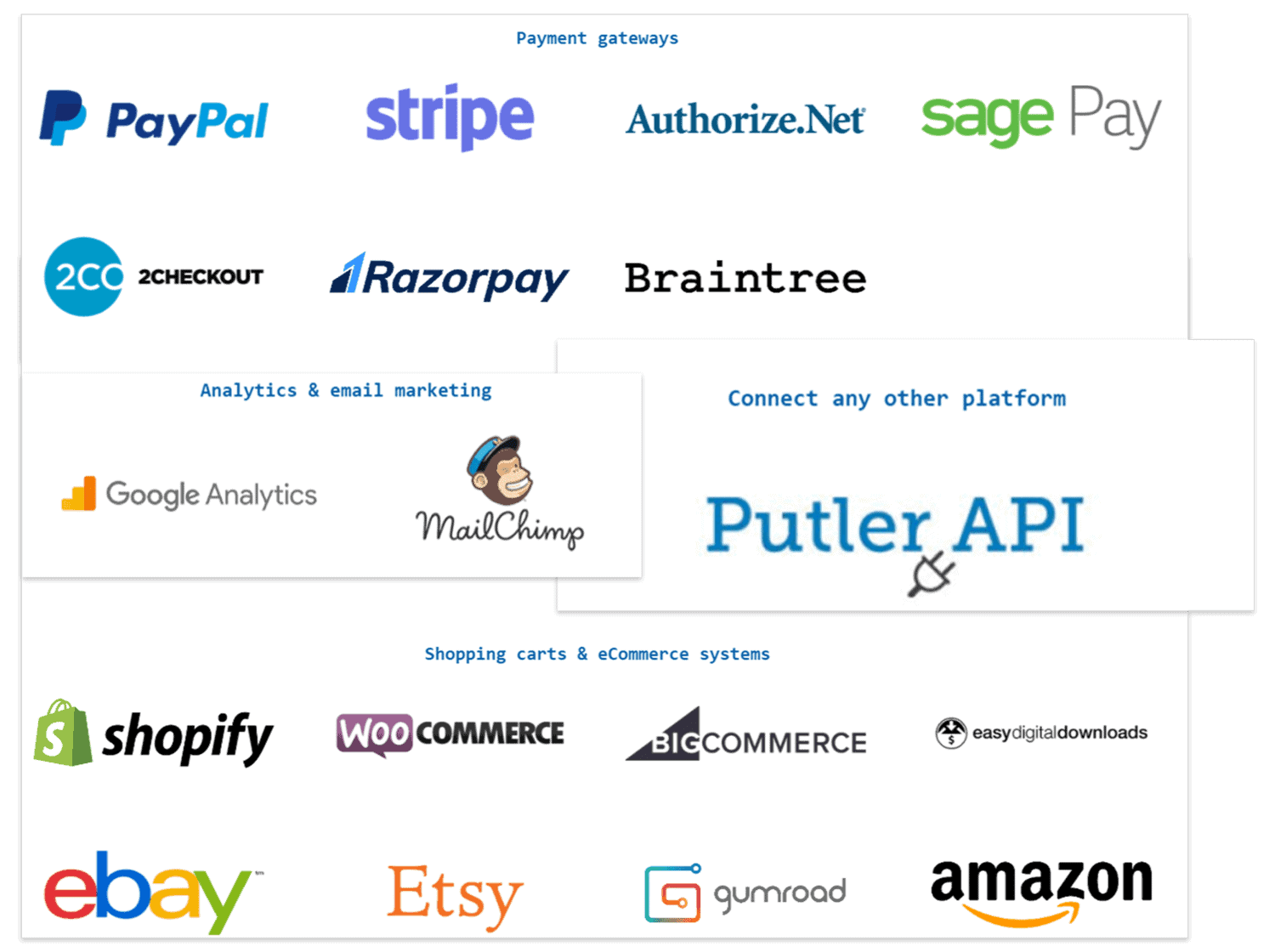
Final thoughts
So, there you have it!
eCommerce analytics may seem daunting, but it doesn’t have to be. With Putler, you can easily track and analyze your business’s performance, make data-driven decisions, and take your online business to the next level. Whether you’re looking for real-time sales data, customer insights, or marketing metrics, Putler has got you covered.
As the world of eCommerce continues to evolve, it’s essential to stay ahead of the game. By keeping up with the latest trends and using cutting-edge tools like Putler, you can stay competitive and thrive in the digital marketplace.
So, what are you waiting for? Try Putler today and see how it can transform your eCommerce business.
FAQs
Which eCommerce analytics tool is the best?
The best eCommerce analytics tool for your business depends on your specific needs and requirements.
To determine which tool is the best fit for your business, you should consider factors such as your budget, the size of your business, your analytics goals, the features and functionalities of each tool, and how user-friendly the tool is.
It’s also worth noting that some eCommerce platforms offer built-in analytics tools, so it’s always worth exploring these options too.
Ultimately, the key is to find a tool that provides the data and insights you need to make informed decisions and grow your business.
Here are some of the best eCommerce analytics tools to help you grow your brand.
What are the key concepts in eCommerce analytics?
eCommerce analytics is a critical aspect of online businesses, enabling them to gather and analyze data on customer behavior and sales strategies.
Key concepts in eCommerce analytics include tracking user behavior to better understand how customers interact with your website, analyzing customer segmentation and creating segmented marketing campaigns to tailor your message to specific audiences, and understanding purchase trends to optimizing your product offerings and pricing.
Additionally, predicting customer lifetime value can help you make strategic decisions about customer acquisition and retention.
By mastering these key concepts, eCommerce businesses can gain a competitive edge and achieve long-term success.
